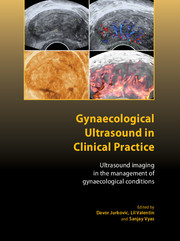 Gynaecological Ultrasound in Clinical Practice
Gynaecological Ultrasound in Clinical Practice Book contents
- Frontmatter
- Contents
- About the authors
- Abbreviations
- Preface
- 1 Ultrasound imaging in gynaecological practice
- 2 Normal pelvic anatomy
- 3 The uterus
- 4 Postmenopausal bleeding: presentation and investigation
- 5 HRT, contraceptives and other drugs affecting the endometrium
- 6 Diagnosis and management of adnexal masses
- 7 Ultrasound assessment of women with pelvic pain
- 8 Ultrasound of non-gynaecological pelvic lesions
- 9 Ultrasound imaging in reproductive medicine
- 10 Ultrasound imaging of the lower urinary tract and uterovaginal prolapse
- 11 Ultrasound and diagnosis of obstetric anal sphincter injuries
- 12 Organisation of the early pregnancy unit
- 13 Sonoembryology: ultrasound examination of early pregnancy
- 14 Diagnosis and management of miscarriage
- 15 Tubal ectopic pregnancy
- 16 Non-tubal ectopic pregnancies
- 17 Ovarian cysts in pregnancy
- Index
Preface
Published online by Cambridge University Press: 05 February 2014
- Frontmatter
- Contents
- About the authors
- Abbreviations
- Preface
- 1 Ultrasound imaging in gynaecological practice
- 2 Normal pelvic anatomy
- 3 The uterus
- 4 Postmenopausal bleeding: presentation and investigation
- 5 HRT, contraceptives and other drugs affecting the endometrium
- 6 Diagnosis and management of adnexal masses
- 7 Ultrasound assessment of women with pelvic pain
- 8 Ultrasound of non-gynaecological pelvic lesions
- 9 Ultrasound imaging in reproductive medicine
- 10 Ultrasound imaging of the lower urinary tract and uterovaginal prolapse
- 11 Ultrasound and diagnosis of obstetric anal sphincter injuries
- 12 Organisation of the early pregnancy unit
- 13 Sonoembryology: ultrasound examination of early pregnancy
- 14 Diagnosis and management of miscarriage
- 15 Tubal ectopic pregnancy
- 16 Non-tubal ectopic pregnancies
- 17 Ovarian cysts in pregnancy
- Index
Summary
This book came about because the Royal College of Obstetricians and Gynaecologists took a decision to integrate gynaecological ultrasound imaging into gynaecological practice and set up a Special Skills Module in gynaecological ultrasound. The theoretical content for this module was delivered at regular meetings in September for seven consecutive years. These meetings were always over-subscribed and enormously popular. We had put together the contents of the meeting and the lectures were delivered by leaders in the field, most of whom are authors in this book.
We would like to think that our efforts led to the next change, which was integration of ultrasound into gynaecology training. This change has now taken place and, thus, the need for a separate training module has disappeared. However, the need for a reference source remains, and this was our driving force in producing this book.
It is clear to us that the use of ultrasound imaging in gynaecology goes well beyond simple picture recognition. A skilful gynaecological sonographer will bring together scan findings and the clinical scenario to enhance patient care. We believe this leads to targeted investigations and, just as importantly, to strategies for non-intervention. We have included chapters on clinical gynaecology, which we believe are essential for making best use of gynaecological ultrasound, and we make no apology for doing so in what some may see as an ultrasound textbook.
- Type
- Chapter
- Information
- Gynaecological Ultrasound in Clinical PracticeUltrasound Imaging in the Management of Gynaecological Conditions, pp. xi - xiiPublisher: Cambridge University PressPrint publication year: 2009
